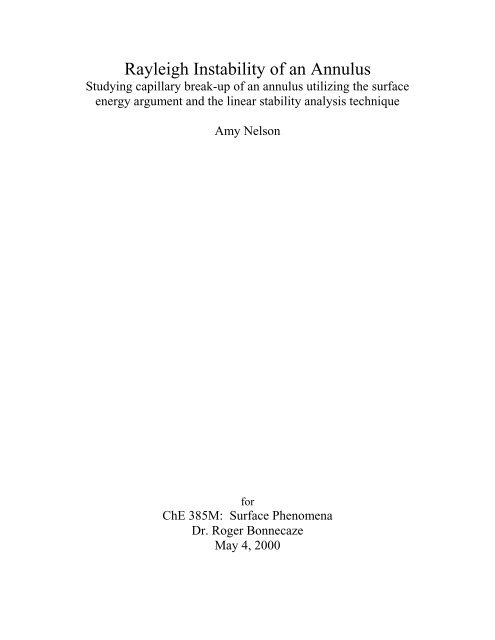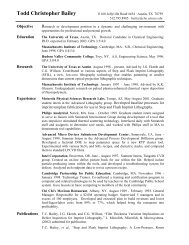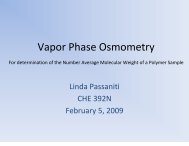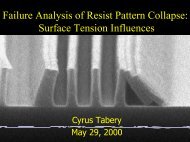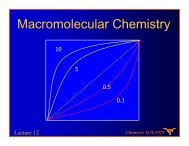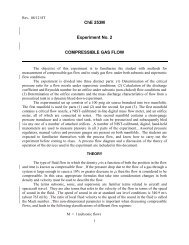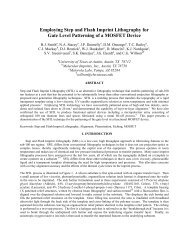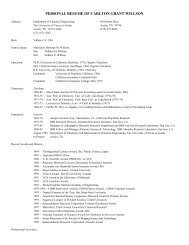Rayleigh Instability of an Annulus
Rayleigh Instability of an Annulus
Rayleigh Instability of an Annulus
You also want an ePaper? Increase the reach of your titles
YUMPU automatically turns print PDFs into web optimized ePapers that Google loves.
<strong>Rayleigh</strong> <strong>Instability</strong> <strong>of</strong> <strong>an</strong> <strong>Annulus</strong><br />
Studying capillary break-up <strong>of</strong> <strong>an</strong> <strong>an</strong>nulus utilizing the surface<br />
energy argument <strong>an</strong>d the linear stability <strong>an</strong>alysis technique<br />
Amy Nelson<br />
for<br />
ChE 385M: Surface Phenomena<br />
Dr. Roger Bonnecaze<br />
May 4, 2000
Introduction<br />
A slow-moving, thin cylindrical stream <strong>of</strong> water will become non-uniform in<br />
diameter <strong>an</strong>d eventually break-up into droplets. This is <strong>an</strong> example <strong>of</strong> capillary break-up<br />
<strong>an</strong>d commonly known as <strong>Rayleigh</strong> instability. For a cylindrical jet, Lord <strong>Rayleigh</strong><br />
calculated that the most unstable disturb<strong>an</strong>ce wavelength is about nine times the radius <strong>of</strong><br />
the jet. This “most d<strong>an</strong>gerous mode” (λ = 9.016*r) has been proven experimentally <strong>an</strong>d<br />
c<strong>an</strong> be derived via linear stability <strong>an</strong>alysis.<br />
The purpose <strong>of</strong> this project was to predict the most unstable disturb<strong>an</strong>ce<br />
wavelength for liquid jet <strong>of</strong> varying <strong>an</strong>nular geometry (0 < κ < 1).<br />
κa 0<br />
a 0<br />
Surface Energy Argument<br />
Figure 1. <strong>Annulus</strong> with outer diameter a 0<br />
A disturb<strong>an</strong>ce will grow only if the process is energetically favorable. The<br />
surface energy argument says that if a disturb<strong>an</strong>ce increases the surface energy <strong>of</strong> the<br />
system, that disturb<strong>an</strong>ce will decay due to restoring forces (viscosity), which will bring<br />
the system to its lowest energy state. Figure 1 shows the cross section <strong>of</strong> the unperturbed<br />
<strong>an</strong>nulus with outer radius, a 0 . Figure 2 shows the lengthwise view <strong>of</strong> the jet <strong>of</strong> const<strong>an</strong>t<br />
thickness with a sinusoidal disturb<strong>an</strong>ce.<br />
a(1+Asin(2πx/L))<br />
a(1+Asin(2πx/L)) - (1-κ)a 0<br />
a 0 (1-κ)<br />
Figure 2. Lengthwise view <strong>of</strong> disturbed system<br />
For <strong>an</strong> inviscid, one-dimensional <strong>an</strong>nular jet, the surface energy argument utilizes<br />
the following equation to establish a relationship between a <strong>an</strong>d a 0 (see figure 2 for<br />
definition <strong>of</strong> a <strong>an</strong>d a 0 ). V is the volume <strong>of</strong> the fluid, x is the axial dist<strong>an</strong>ce, L is the<br />
2
wavelength <strong>of</strong> the disturb<strong>an</strong>ce, A is the amplitude <strong>of</strong> the disturb<strong>an</strong>ce, <strong>an</strong>d κ is the ratio <strong>of</strong><br />
the inner radius to the outer radius.<br />
L<br />
⎛<br />
V = ∫ π − a + A<br />
⎝<br />
0<br />
⎛ 2πx⎞<br />
⎝ L ⎠<br />
⎞<br />
dx a0<br />
πL<br />
⎠<br />
2 2<br />
2<br />
( 1 κ ) ⎜1<br />
sin⎜<br />
⎟ ⎟ = ( 1−<br />
κ )<br />
⎛ ⎞<br />
= a ⎜1+<br />
1 2<br />
a<br />
0<br />
A ⎟<br />
⎝ 2 ⎠<br />
The expression for the surface area <strong>of</strong> the fluid is as follows.<br />
L<br />
⎛<br />
S= 2× ∫2π<br />
a ⎜1+<br />
Asin<br />
⎝<br />
0<br />
−<br />
L<br />
∫<br />
0<br />
⎛<br />
⎜<br />
⎝<br />
1 − 2<br />
2π( 1−<br />
κ)<br />
a<br />
2<br />
⎞ ⎞ aA<br />
⎟ ⎟ + ⎛ 2<br />
2π x ⎛<br />
⎠ ⎠ ⎝ ⎜ 2π ⎞ 2 ⎛ 2π<br />
⎜1<br />
⎟ cos ⎜<br />
L ⎝ L ⎠ ⎝<br />
0<br />
dl<br />
x<br />
L<br />
⎞ ⎞<br />
⎟ ⎟<br />
⎠ ⎠<br />
1 2<br />
dx<br />
(1)<br />
(2)<br />
Now, to calculate the ch<strong>an</strong>ge in surface energy the following equation applies where E is<br />
the surface energy <strong>of</strong> the system, γ is the surface tension <strong>of</strong> the fluid, <strong>an</strong>d S 0 is the surface<br />
area <strong>of</strong> the unperturbed system.<br />
( )<br />
∆E = γ S−S 0<br />
S = 2πLa<br />
( 1−<br />
κ)<br />
0 0<br />
(3)<br />
For details <strong>of</strong> the calculations, see the attached appendix.<br />
Linear Stability Analysis<br />
A linear stability <strong>an</strong>alysis provides more information about the disturb<strong>an</strong>ce.<br />
Information such as whether or not a disturb<strong>an</strong>ce will grow <strong>an</strong>d the value <strong>of</strong> the most<br />
unstable wavelength c<strong>an</strong> be obtained. If only small perturbations are <strong>of</strong> interest, terms<br />
involving the squares <strong>of</strong> or products <strong>of</strong> the disturb<strong>an</strong>ce amplitude c<strong>an</strong> be neglected<br />
therefore making the equations linear. The <strong>an</strong>alysis was based on the following<br />
assumptions:<br />
a. The fluid is inviscid <strong>an</strong>d incompressible<br />
b. The disturb<strong>an</strong>ce amplitude is very small (Amplitude, A
Conservation <strong>of</strong> Momentum:<br />
ρ ∂ u'<br />
=−∇ p '<br />
(5)<br />
∂t<br />
Here ρ is the density <strong>of</strong> the fluid <strong>an</strong>d p' is the pressure in the fluid.<br />
Kinematic Expression:<br />
ur ' = ∂η<br />
∂t<br />
Here η is the length <strong>of</strong> the disturb<strong>an</strong>ce <strong>an</strong>d u' r is the radial velocity <strong>of</strong> the fluid.<br />
(6)<br />
For a sinusoidal disturb<strong>an</strong>ce p' , η, u' <strong>an</strong>d c<strong>an</strong> all be described by Β in the following<br />
expression:<br />
B= B ! exp ( st+ i( k z+<br />
n θ ))<br />
Here, s is the time factor, k is the wave number (k= 2π/λ where λ is the wavelength <strong>of</strong> the<br />
disturb<strong>an</strong>ce), <strong>an</strong>d n is the <strong>an</strong>gular number that determines the shape <strong>of</strong> the disturb<strong>an</strong>ce.<br />
The value <strong>of</strong> n is assumed to be zero (symmetrical disturb<strong>an</strong>ce) for this study to eliminate<br />
<strong>an</strong>y imaginary component <strong>of</strong> the solution. Combining equations 4 <strong>an</strong>d 5 yields the<br />
following differential equation whose solution is a zero order modified Bessel’s equation.<br />
The order <strong>of</strong> the Bessel equation is determined by the value <strong>of</strong> n.<br />
r dp 2<br />
!<br />
r dp !<br />
2<br />
2 2 2 2<br />
2 + − (r k + n ) p! = 0 = ∇ p'<br />
(6)<br />
dr dr<br />
Boundary Conditions<br />
!p (r) = AI ( kr) + BK ( kr)<br />
(7)<br />
n<br />
n<br />
The following boundary conditions were used to solve the differential equation.<br />
This first boundary condition requires that the normal stresses be bal<strong>an</strong>ced at the outer<br />
interface. This equation is also known as the Young-Laplace equation where n is the<br />
normal vector, γ is the surface tension <strong>of</strong> the fluid, <strong>an</strong>d a is the unperturbed outer radius<br />
<strong>of</strong> the <strong>an</strong>nulus (equivalent to a 0 in figure 1).<br />
2<br />
2<br />
p'| r= a+ =− ⎛ η<br />
⎜<br />
n<br />
⎝ a + ∂ η<br />
z + 1 ∂ η⎞<br />
η γ 2 2 2 2 ⎟ =∇•<br />
(8)<br />
∂ a ∂θ ⎠<br />
The second boundary condition comes from the fact that the radial velocity at the<br />
outer interface is equal to the time derivative <strong>of</strong> the length <strong>of</strong> the disturb<strong>an</strong>ce (equation 6).<br />
Ak<br />
u! '( ) '( )<br />
r a s I ka Bk<br />
s K ka ∂η<br />
r| = + =<br />
= +<br />
0 0<br />
(9)<br />
η ρ ρ<br />
∂t<br />
4
A third boundary condition is needed to achieve three simult<strong>an</strong>eous equations<br />
from which to solve for A, B, <strong>an</strong>d η ! . If it is assumed that the perturbations are coupled<br />
<strong>an</strong>d the wall <strong>of</strong> the <strong>an</strong>nulus is <strong>of</strong> const<strong>an</strong>t thickness (boundary condition on which the<br />
surface energy argument was based), then the third boundary condition requires that the<br />
radial velocity <strong>of</strong> the inner surface equal the radial velocity <strong>of</strong> the outer surface.<br />
Ak<br />
u! '( ) '( )<br />
r a s I ka Bk<br />
s K ka ∂η<br />
r| = + =<br />
= κ +<br />
0<br />
κ<br />
0<br />
κ<br />
(10)<br />
η ρ<br />
ρ<br />
∂t<br />
However, if it is assumed that the inner wall <strong>of</strong> the <strong>an</strong>nulus remains stationary<br />
resulting in a non-const<strong>an</strong>t wall thickness, then the final boundary condition becomes<br />
much simpler.<br />
u! |<br />
r r = a<br />
= 0 (11)<br />
κ + η<br />
Results<br />
For the base case system (cylindrical, no <strong>an</strong>nulus) the surface energy argument<br />
shows that a disturb<strong>an</strong>ce will grow for wavelengths greater th<strong>an</strong> 2πa 0 where a 0 is the<br />
unperturbed radius <strong>of</strong> the cylinder. The results <strong>of</strong> the surface energy argument for the<br />
<strong>an</strong>nular case show that this critical wavelength does not ch<strong>an</strong>ge. Therefore, there is no<br />
κ dependence on the critical wavelength.<br />
The equations derived from the linear stability <strong>an</strong>alysis were solved for the time<br />
factor. The time factor, s, was solved with two different sets <strong>of</strong> boundary conditions. The<br />
result for s assuming coupled perturbations is as follows. Detailed calculations c<strong>an</strong> be<br />
found in the appendix. Here, α is ka. A plot <strong>of</strong> α versus s is shown in Figure 3.<br />
s<br />
0.5<br />
0.45<br />
0.4<br />
0.35<br />
0.3<br />
0.25<br />
s =<br />
2<br />
( 1−<br />
) K ( ) I ( )( 1−<br />
K ( )<br />
0' 0' 0'<br />
)<br />
γα α κα α α<br />
3<br />
ρaI( ) ( )<br />
0<br />
α I0'<br />
κα<br />
⎛ I ( ) ⎞ ⎡ K ( ) K ( ) ⎤ K ( ) I ( ) K ( )<br />
0'<br />
α<br />
0<br />
α<br />
0'<br />
κα<br />
0' κα<br />
0' α −<br />
0'<br />
κα<br />
⎜ − 1⎟<br />
−<br />
⎝ I ( ) ⎢<br />
⎠ ⎣ I ( ) I ( ) ⎥ +<br />
κα α<br />
I ( )<br />
0'<br />
0<br />
n'<br />
κα ⎦<br />
0'<br />
κα<br />
Figure 3: <strong>Annulus</strong>, Figure kappa = 4: 0.0 <strong>Annulus</strong>, to 0.9 kappa = 0.0 to 0.9<br />
3.5<br />
The result for s assuming the inner wall is stationary is as follows. A plot <strong>of</strong><br />
κ = 0.9<br />
3<br />
α versus s for this case is shown in Figure κ = 0.9<br />
4.<br />
s<br />
2.5<br />
2<br />
s =<br />
2<br />
( 1−<br />
) I ( )<br />
γα α ( )<br />
0<br />
κα ⎛ K ⎞<br />
0'<br />
α<br />
3 ⎜ K ( )<br />
0<br />
α − ⎟<br />
ρaI( )<br />
( )<br />
0<br />
α ⎝ I0'<br />
α ⎠<br />
κ =0<br />
⎛ K ( α) I ( κα)<br />
⎞ K ( ) K ( )<br />
⎜ K ( ) −<br />
I ( )<br />
⎝<br />
I ( ) ⎠<br />
⎟ − ⎛ α<br />
⎜<br />
⎝ I ( )<br />
+ α ⎞<br />
0'<br />
0<br />
0<br />
0'<br />
0<br />
α<br />
0<br />
κα<br />
⎟<br />
' α<br />
α I '( α)<br />
⎠<br />
0<br />
0<br />
0<br />
(12)<br />
(13)<br />
0.2<br />
0.15<br />
1.5<br />
1<br />
κ = 0.5<br />
0.1<br />
κ = 0.1<br />
0.5<br />
κ =0.01<br />
0.05<br />
κ = 0<br />
0<br />
0<br />
0 0.1 0.2 0.30 0.4 0.1 0.5 0.2 0.6 0.3 0.7 0.4 0.8 0.5 0.9 0.6 10.7 0.8 0.9 1<br />
5<br />
alpha<br />
alpha
Conclusion<br />
It c<strong>an</strong> be seen in both the cases that the critical wavelength (λ c = 2πa) hasn’t<br />
ch<strong>an</strong>ged from the base case (κ = 0). This is in agreement with the surface energy<br />
argument. For a jet <strong>of</strong> cylindrical geometry (κ = 0), the most d<strong>an</strong>gerous mode occurs at s<br />
= 0.6203, α = 0.697, λ = 9*a. The first case where the perturbations are assumed to be<br />
coupled, the wavelength at which this maximum occurs doesn’t ch<strong>an</strong>ge much. However,<br />
it c<strong>an</strong> be seen that the time factor <strong>of</strong> the disturb<strong>an</strong>ce increases as κ is increased (thinner<br />
wall). This corresponds to a faster growing disturb<strong>an</strong>ce. It c<strong>an</strong> be concluded then, that<br />
for a coupled disturb<strong>an</strong>ce (which is the most reasonable assumption for <strong>an</strong> inviscid case),<br />
the jet will break up into droplets <strong>of</strong> equal length as the cylindrical case but it will break<br />
up more quickly.<br />
In the case where the inner wall is stationary, the wall is not <strong>of</strong> uniform thickness.<br />
Figure 4 show that the maximum disturb<strong>an</strong>ce occurs at infinite wavelength as κ is<br />
increased from zero. In this case, the longer wavelength the disturb<strong>an</strong>ce, the more<br />
quickly the disturb<strong>an</strong>ce grows. This case is the less feasible <strong>of</strong> the two cases because in<br />
the case <strong>of</strong> <strong>an</strong> inviscid fluid, there will be a disturb<strong>an</strong>ce imposed on the inner surface.<br />
The former case will most closely approach reality.<br />
References<br />
1. Miller, C., Interfacial Phenomena, Marcel Dekker (1985)<br />
2. Abramowitz, M. <strong>an</strong>d Stegun, I., H<strong>an</strong>dbook <strong>of</strong> Mathematical Functions, Dover<br />
Publications (1965)<br />
6


